Why is measuring the dew point of gases important in various industrial and environmental applications?
Measuring the dew point of gases is important in various industrial and environmental applications for several key reasons:
- Moisture Control and Management: Dew point measurement helps in controlling and managing the moisture content of gases. It allows industries to maintain precise humidity levels, which is crucial in processes where even slight deviations can lead to product quality issues or equipment damage.
- Corrosion Prevention: In industrial applications, moisture can lead to corrosion and degradation of equipment and infrastructure. By measuring and controlling the dew point, industries can prevent the formation of condensation, which is a primary cause of corrosion, especially in pipelines, storage tanks, and heat exchangers.
- Energy Efficiency: Maintaining optimal humidity levels is essential for energy efficiency. In heating, ventilation, and air conditioning (HVAC) systems, for example, the dew point affects the efficiency of heat exchange. Accurate dew point measurement allows for the precise adjustment of these systems, resulting in energy savings.
- Product Quality Assurance: In industries like food and pharmaceuticals, maintaining the right humidity levels is critical for ensuring the quality and safety of products. Accurate dew point measurement helps in quality control and compliance with industry standards and regulations.
- Safety: In applications involving flammable gases, the presence of moisture can affect the flammability range and lead to safety hazards. Measuring and controlling the dew point helps ensure safe operating conditions and reduces the risk of accidents.
- Environmental Compliance: In emissions control and environmental monitoring, knowing the moisture content of gases is essential. Accurate dew point measurement helps industries meet regulatory requirements for emissions control and reduces environmental impact.
- Process Optimization: Dew point measurement is a valuable tool for process optimization. It allows industries to fine-tune their processes, improve efficiency, and reduce operational costs. For example, in natural gas processing, maintaining a specific dew point is critical for gas quality and pipeline integrity.
- Equipment Reliability: Maintaining the proper humidity levels in electrical and electronic systems is essential to prevent short circuits and electrical failures. Accurate dew point measurement helps protect sensitive equipment and ensures its reliability.
- Hydrocarbon Processing: In the oil and gas industry, controlling the dew point of hydrocarbon gases is vital for preventing hydrate formation, which can block pipelines and cause operational problems.
- Predictive Maintenance: Dew point measurements can be used as part of predictive maintenance programs. They provide data that helps industries schedule maintenance and repairs based on the moisture condition of equipment and systems, reducing the risk of unexpected failures.
- Data Center Cooling: In data centers, gas dew point meter precise control of humidity levels is critical for ensuring the reliability of servers and IT equipment. Dew point measurement is used to maintain the right environmental conditions.
In summary, measuring the dew point of gases is essential for quality control, safety, equipment reliability, energy efficiency, and compliance with regulations in various industrial and environmental applications. It helps prevent moisture-related issues, improves processes, and contributes to the overall efficiency and sustainability of these applications.
How does a Gas Dew Point Meter work?
A Gas Dew Point Meter is an instrument used to measure the dew point temperature of a gas, which indicates the temperature at which moisture or water vapor in the gas will condense into liquid form. The principle behind the operation of a Gas Dew Point Meter is typically based on chilled mirror technology. Here’s how it works:
- Chilled Mirror Principle:
- The core of a Gas Dew Point Meter is a surface, often a mirror, that can be cooled to very low temperatures.
- Temperature Adjustment:
- The mirror’s temperature is adjusted by a cooling system to a level below the expected dew point temperature of the gas being measured.
- Exposure to Gas Sample:
- A gas sample is exposed to the mirror’s surface. The mirror is usually part of a closed chamber, and the gas flows through or around the mirror.
- Condensation Detection:
- As the gas sample comes into contact with the chilled mirror surface, any moisture or water vapor in the gas will begin to condense on the mirror due to the temperature difference. This is where the dew point occurs.
- Temperature Measurement:
- The Gas Dew Point Meter continuously measures the temperature of the mirror’s surface.
- Dew Point Calculation:
- The meter calculates the temperature at which condensation occurred, which is the dew point of the gas sample. This calculation is based on the measured mirror temperature.
- Display and Readout:
- The calculated dew point temperature is displayed on the meter’s screen, usually in degrees Celsius (°C) or degrees Fahrenheit (°F), providing a direct indication of the gas’s moisture content.
Key Features and Components of a Gas Dew Point Meter:
- Mirror Surface: The mirror surface is the essential component where condensation occurs. It is made of a material that can be cooled to low temperatures without suffering damage.
- Temperature Sensor: The instrument is equipped with a precise temperature sensor that measures the mirror’s temperature.
- Cooling System: A cooling system is used to maintain the mirror’s temperature below the dew point temperature of the gas sample. It can be a Peltier cooler or another type of refrigeration system.
- Control and Display: The Gas Dew Point Meter includes a control panel or interface that allows users to set parameters and view the dew point temperature.
- Gas Inlet/Outlet: The meter has connections for gas inlet and outlet to facilitate the flow of the gas sample.
By employing this chilled mirror principle, a Gas Dew Point Meter provides accurate and reliable measurements of the dew point temperature of gases, which is critical in various industrial and environmental applications to assess and control humidity levels and prevent issues related to moisture content.

